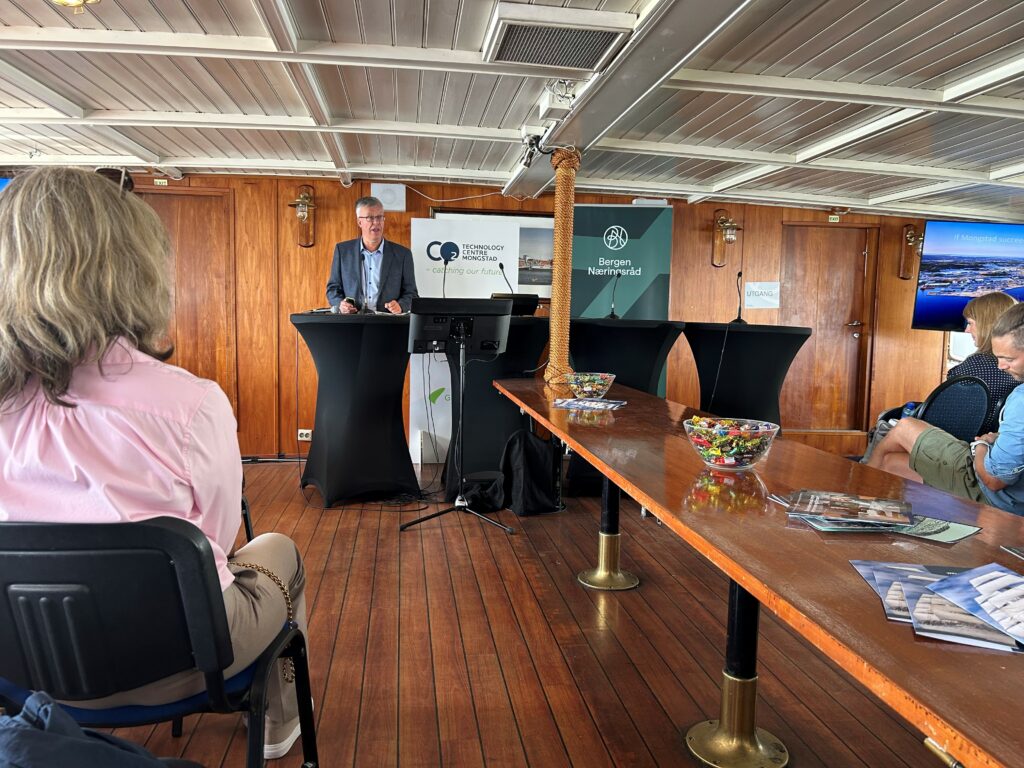
20.08.2025
Carbon Capture: A Key Driver of Green Industrial Growth at Mongstad
Carbon capture and storage (CCS) could stimulate the development of existing and new industries at Mongstad.
With world-leading expertise at the Mongstad Technology Centre (TCM) and ambitious plans for industrial transformation, the region is facing a turning point that could define its industrial future.
Together with TCM, Greenspot Mongstad organized a meeting during Arendalsuka on how zero emissions can become a reality in Norwegian industry. Mongstad’s industrial sector alone accounts for approximately 3.5 percent of Norway’s total CO2 emissions. In his presentation, project manager Einar Vaage outlined ongoing initiatives to tackle this major challenge.

The Industrial Park – A National Heavyweight
Mongstad Industrial Park currently hosts 3,500 full-time positions across 63 companies, primarily in oil- and gas-related operations. It serves as the supply hub for 23 offshore platforms in the North Sea. Behind these large numbers, however, lies a challenge: Equinor Mongstad emits around 1.6 million tonnes of CO2 annually – equivalent to 3–3.5% of Norway’s total emissions.
According to Vaage, the solution is to renew the industry and create new activity that both secures jobs and reduces the climate footprint.
Two Priorities for Green Transformation
Vaage highlighted two main initiatives that could reshape Mongstad in the coming years:
- Refinery Optimization – Increase competitiveness while reducing CO2 emissions.
- New Primary Industries:
- Steel pellet production from ore using gas as a reducing agent, combined with CCS.
- Sustainable aquaculture – land-based salmon farming with a capacity of 2,000 tonnes of smolt and 43,000 tonnes of market fish, scheduled to start in 2028.
- SAF (Sustainable Aviation Fuel) – production of sustainable jet fuel using residual waste as feedstock.
Linked to these new industries, we are already seeing development and establishment of both new and existing supplier environments.
CCS – The Glue That Binds the Industry
According to Vaage, carbon capture and storage is absolutely essential for a successful transformation.
The plan is to increase the concentration of CO2 at Mongstad by attracting industries such as steel production and SAF, which will contribute millions of tonnes of CO2. This will make it economically viable to build a pipeline to the Smeaheia field in the North Sea – both to manage current emissions at Mongstad and to transport CO2 from other regional actors.
“To address today’s emissions, we actually need more CO2 – which is why the expertise offered by TCM is so incredibly important,” Vaage emphasized.

Strong Political Signals
During the subsequent debate, both the acting mayor of Alver, Nina Bognøy, and the county mayor of Vestland, Jon Askeland, voiced their support for the plans.
Bognøy recalled Mongstad’s history: “It’s been 50 years since we forcibly emptied a village of its people. We cannot abandon Mongstad now. We owe it to the community to secure new industries there – which is also important for the region and for the country.”
Askeland highlighted Norway’s opportunity to lead: “The bigger you are, the more you must do, and those with the most must contribute the most. Norway has the knowledge and resources to take the lead. TCM is an international star, and the Mongstad refinery has already contributed to emissions reductions multiple times through the delivery of flue gas to TCM and ongoing technology development.”
He expressed a strong desire for faster action: “We are close to large storage reservoirs in the North Sea. I hope we can soon link TCM and the refinery so that we can eliminate greenhouse gas emissions once and for all.”
A Turning Point for Mongstad
With a combination of established industry, new green technologies, and political will, Mongstad could become a hub for green transformation. CCS sits at the heart of this transition – not just as a climate tool, but as a prerequisite for creating new value.
If these plans are realized, Mongstad could, within the next decade, transition from an emissions source to a model for industrial climate solutions, both in Norway and internationally.
